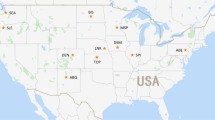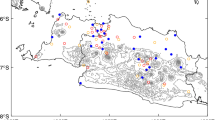Abstract
In addition to common synoptic wind system, the mountainous terrain forms a local thermally driven wind system, which makes the mountain wind system have strong terrain dependence. Therefore, in order to estimate the reliable design wind speeds for structural safety, the samples for extreme wind speeds for certain return periods at mountainous areas can only come from field measurements at construction site. However, wind speeds measuring duration is usually short in real practice. This work proposes a novel method for calculating extreme wind speeds in mountainous areas by using short-term field measurement data and long-term nearby meteorological observatory data. Extreme wind speeds in mountainous area are affected by mixed climates composed by local-scale wind and large-scale synoptic wind. The local winds can be recorded at construction site with short observatory time, while the extreme wind speeds samples from synoptic wind climate from nearby meteorological station with long observatory time is extracted for data augmentation. The bridge construction site at Hengduan Mountains in southwestern China is taken as an example in this study. A 10-month dataset of field measurement wind speeds is recorded at this location. This study firstly provides a new method to extract wind speed time series of windstorms. Based on the different windstorm features, the local and synoptic winds are separated. Next, the synoptic wind speeds from nearby meteorological stations are converted and combined with local winds to derive the extreme wind speeds probability distribution function. The calculation results shows that the extreme wind speed in the short return period is controlled by the local wind system, and the long-period extreme wind speed is determined by the synoptic wind system in the mountain area. The descending slope of the synoptic wind speed exceeding probability exceeds the local wind by about 20%. If the influence of mixed climate is not considered, and the wind speed samples are not divided by category, the decline slope will be 7% lower.
























Similar content being viewed by others
References
Abd-Elaal ES, Mills JE, Ma X (2018) Numerical simulation of downburst wind flow over real topography. J Wind Eng Ind Aerodyn 172:85–95
ASCE (2016) Minimum design loads for building and other structures (ASCE 7-16)
Beine H, Argentini S, Maurizi A et al (2001) The local wind field at ny-å lesund and the zeppelin mountain at svalbard. Meteorol Atmos Phys 78(1):107–113
Bitsuamlak G, Stathopoulos T, Bedard C (2004) Numerical evaluation of wind flow over complex terrain. J Aerosp Eng 17(4):135–145
Cao S, Wang T, Ge Y et al (2012) Numerical study on turbulent boundary layers over two-dimensional hills-effects of surface roughness and slope. J Wind Eng Ind Aerodyn 104:342–349
Chen G, Lombardo FT (2020) An automated classification method of thunderstorm and non-thunderstorm wind data based on a convolutional neural network. J Wind Eng Ind Aerodyn 207(104):407
Choi E, Tanurdjaja A (2002) Extreme wind studies in singapore an area with mixed weather system. J Wind Eng Ind Aerodyn 90(12–15):1611–1630
Cook N (1982) Towards better estimation of extreme winds. J Wind Eng Ind Aerodyn 9(3):295–323
Cook NJ (2004) Confidence limits for extreme wind speeds in mixed climates. J Wind Eng Ind Aerodyn 92(1):41–51
Cook NJ, Harris RI, Whiting R (2003) Extreme wind speeds in mixed climates revisited. J Wind Eng Ind Aerodyn 91(3):403–422
Cui W, Caracoglia L (2020) Performance-based wind engineering of tall buildings examining life-cycle downtime and multisource wind damage. J Struct Eng 146(1):04019,179
Cui W, Ma T, Zhao L et al (2021) Data-based windstorm type identification algorithm and extreme wind speed prediction. J Struct Eng 147(5):04021,053
De Gaetano P, Repetto MP, Repetto T et al (2014) Separation and classification of extreme wind events from anemometric records. J Wind Eng Ind Aerodyn 126:132–143
Deng H, Runger G, Tuv E et al (2013) A time series forest for classification and feature extraction. Inf Sci 239:142–153
Fisher RA, Tippett LHC (1928) Limiting forms of the frequency distribution of the largest or smallest member of a sample. In: Mathematical proceedings of the Cambridge philosophical society, Cambridge University Press, pp 180–190
Fulcher BD, Jones NS (2014) Highly comparative feature-based time-series classification. IEEE Trans Knowl Data Eng 26(12):3026–3037
Gaidai O, Naess A, Xu X et al (2019) Improving extreme wind speed prediction based on a short data sample, using a highly correlated long data sample. J Wind Eng Ind Aerodyn 188:102–109
Gomes L, Vickery B (1977) On the prediction of extreme wind speeds from the parent distribution. J Wind Eng Ind Aerodyn 2(1):21–36
Gomes L, Vickery B (1978) Extreme wind speeds in mixed wind climates. J Wind Eng Ind Aerodyn 2(4):331–344
Gumbel EJ (2004) Statistics of extremes. Courier Corporation
Harris R (1999) Improvements to themethod of independent storms’. J Wind Eng Ind Aerodyn 80(1–2):1–30
Holmes JD (2007) Wind loading of structures. CRC Press, Boca Raton
van der Hoven I (1957) Power spectrum of horizontal wind speed in the frequency range from 0.0007 to 900 cycles per hour. J Atmos Sci 14(2):160–164
Huang G, Jiang Y, Peng L et al (2019) Characteristics of intense winds in mountain area based on field measurement: focusing on thunderstorm winds. J Wind Eng Ind Aerodyn 190:166–182
Jackson PL, Mayr G, Vosper S (2013) Dynamically-driven winds. Mountain weather research and forecasting. Springer, Berlin, pp 121–218
Jing H, Liao H, Ma C et al (2020) Field measurement study of wind characteristics at different measuring positions in a mountainous valley. Exp Thermal Fluid Sci 112(109):991
Kim HG, Patel V, Lee CM (2000) Numerical simulation of wind flow over hilly terrain. J Wind Eng Ind Aerodyn 87(1):45–60
Kwok KC, Hitchcock PA, Burton MD (2009) Perception of vibration and occupant comfort in wind-excited tall buildings. J Wind Eng Ind Aerodyn 97(7–8):368–380
Li C, Chen Z, Zhang Z et al (2010) Wind tunnel modeling of flow over mountainous valley terrain. Wind Struct 13(3):275
Li Y, Zhang M, Xu X et al (2014) Causes of daily strong wind on bridge site in deep gorge with high altitude and high temperature difference. J Southwest Jiaotong Univ 49(6):935–941
Li Y, Xu X, Zhang M et al (2017) Wind tunnel test and numerical simulation of wind characteristics at a bridge site in mountainous terrain. Adv Struct Eng 20(8):1223–1231
Lombardo FT, Main JA, Simiu E (2009) Automated extraction and classification of thunderstorm and non-thunderstorm wind data for extreme-value analysis. J Wind Eng Ind Aerodyn 97(3–4):120–131
Maurizi A, Palma J, Castro F (1998) Numerical simulation of the atmospheric flow in a mountainous region of the north of portugal. J Wind Eng Ind Aerodyn 74:219–228
Mingjin Z, Jisheng Y, Jingyu Z et al (2019) Study on the wind-field characteristics over a bridge site due to the shielding effects of mountains in a deep gorge via numerical simulation. Adv Struct Eng 22(14):3055–3065
Palutikof J, Brabson B, Lister D et al (1999) A review of methods to calculate extreme wind speeds. Meteorol Appl J Forecast Pract Appl Train Tech Modell 6(2):119–132
Pavan M, Mizzaro S, Scagnetto I (2017) Mining movement data to extract personal points of interest: a feature based approach. Information filtering and retrieval. Springer, Berlin, pp 35–61
Ren H, Laima S, Chen WL et al (2018) Numerical simulation and prediction of spatial wind field under complex terrain. J Wind Eng Ind Aerodyn 180:49–65
Rice SO (1944) Mathematical analysis of random noise. Bell Syst Tech J 23(3):282–332
Simiu E, Heckert N (1996) Extreme wind distribution tails: a peaks over threshold approach. J Struct Eng 122(5):539–547
Simiu E, Yeo D (2019) Wind effects on structures: modern structural design for wind. John Wiley and Sons, New Jersey
Simo-Serra E, Trulls E, Ferraz L, et al (2015) Discriminative learning of deep convolutional feature point descriptors. In: Proceedings of the IEEE international conference on computer vision, pp 118–126
Tongji-University (2018) Wind-resistant design specification for highway bridges (JTG/T 3360-01-2018)
Tse KT, Weerasuriya AU, Hu G (2020) Integrating topography-modified wind flows into structural and environmental wind engineering applications. J Wind Eng Ind Aerodyn 204(104):270
Twisdale LA, Vickery PJ (1992) Research on thunderstorm wind design parameters. J Wind Eng Ind Aerodyn 41(1–3):545–556
Wagner A (1938) Theorie und beobachtung der periodischen gebirgswinde (theory and observation of periodic mountain winds). Gerlands Beitr Geophys 52:408–449
Wang Q (2001) A bayesian joint probability approach for flood record augmentation. Water Resour Res 37(6):1707–1712
Whiteman CD (1990) Observations of thermally developed wind systems in mountainous terrain. Atmospheric processes over complex terrain. Springer, Berlin, pp 5–42
Young AH, Knapp KR, Inamdar A et al (2018) The international satellite cloud climatology project h-series climate data record product. Earth Syst Sci Data 10(1):583–593
Zardi D, Whiteman CD (2013) Diurnal mountain wind systems. Mountain weather research and forecasting, pp 35–119
Zhang J, Zhang M, Li Y et al (2020) Comparison of wind characteristics at different heights of deep-cut canyon based on field measurement. Adv Struct Eng 23(2):219–233
Zhang M, Zhang J, Li Y et al (2020) Wind characteristics in the high-altitude difference at bridge site by wind tunnel tests. Wind Struct 30(6):547–558
Zhao J, Itti L (2015) Classifying time series using local descriptors with hybrid sampling. IEEE Trans Knowl Data Eng 28(3):623–637
Funding
The authors gratefully acknowledge the support of National Natural Science Foundation of China (52078383, 52008314) and Independent subject of State Key Lab of Disaster Reduction in Civil Engineering (SLDRCE19-B-11).
Author information
Authors and Affiliations
Contributions
Conceptualization: CW, MT; Methodology: MT; Formal analysis and investigation: MT, CW; Data curation: WC, YD; Writing - origin draft preparation: MT; Writing - review and editing: CW, ZL; Funding acquisition: CW, ZL; Supervision: GF, ZL, GY.
Corresponding author
Ethics declarations
Conflict of interest
All authors certify that they have no affiliations with or involvement in any organization or entity with any financial interest or non-financial interest in the subject matter or materials discussed in this manuscript.
Additional information
Publisher's Note
Springer Nature remains neutral with regard to jurisdictional claims in published maps and institutional affiliations.
Rights and permissions
Springer Nature or its licensor (e.g. a society or other partner) holds exclusive rights to this article under a publishing agreement with the author(s) or other rightsholder(s); author self-archiving of the accepted manuscript version of this article is solely governed by the terms of such publishing agreement and applicable law.
About this article
Cite this article
Ma, T., Cui, W., Zhao, L. et al. Extreme wind speed prediction in mountainous area with mixed wind climates. Stoch Environ Res Risk Assess 37, 1163–1181 (2023). https://doi.org/10.1007/s00477-022-02335-7
Accepted:
Published:
Issue Date:
DOI: https://doi.org/10.1007/s00477-022-02335-7




